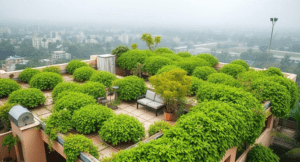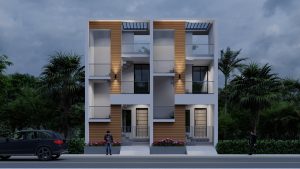When it comes to building or designing a house, every small detail matters from the layout of the rooms to the amount of natural light and ventilation. One feature that often comes up in architectural plans is OTS, but many homeowners are not familiar with the term or its purpose.
OTS (Open to Sky) is an increasingly common element in modern house designs, especially in urban areas where space is limited and houses are built close to each other. In such homes, external windows may not always provide enough sunlight or air circulation. This is where OTS plays a big role it acts like a breathing space within the house.
An OTS is essentially a small open area within the house structure that is directly exposed to the sky. It brings natural light and fresh air into the inner parts of the home, making rooms feel brighter, fresher, and more comfortable. Beyond just functionality, OTS can also add aesthetic appeal some homeowners use it as a mini garden, a decorative feature, or even a relaxation corner.
In this blog, we’ll explain everything you need to know about OTS in house design what it is, its purpose, why it’s important, its advantages and disadvantages, design tips, and how you can cover it smartly.
Table of Contents
ToggleWhat is OTS in House Design?
OTS stands for “Open to Sky.”
It is an open vertical space within a house that has no roof covering. OTS allows natural sunlight and fresh air to reach the inner rooms of a home.
Think of it as a mini courtyard or vertical shaft inside the house. It’s commonly placed between rooms, near staircases, or at the center of compact homes where external windows may not be possible.
Purpose of an OTS Area
The main purpose of OTS (Open to Sky) is to ensure that your home gets enough natural light and proper ventilation. In today’s cities, houses are often built on small plots, and walls of neighboring homes are very close to each other. This makes it difficult for light and air to reach the inside of the house. OTS solves this problem by acting as a natural source of daylight and fresh air circulation.
Here’s how OTS serves different purposes:
Bringing sunlight to darker areas of the home:
Rooms like bathrooms, staircases, or bedrooms located in the middle of the house may not get enough natural light. An OTS allows direct sunlight to enter these spaces, reducing the dull and gloomy feel.Allowing natural air circulation in closed rooms:
Without proper airflow, rooms can feel suffocating or damp. An OTS works like a natural ventilation shaft, allowing fresh air to enter and stale air to escape, keeping the indoor environment healthy.Reducing the need for artificial lighting during daytime:
With enough daylight coming in through OTS, you don’t need to switch on lights during the day. This lowers electricity usage and saves money on energy bills.Creating a more comfortable and healthy indoor atmosphere:
Natural sunlight kills harmful bacteria and keeps the house fresh, while airflow helps regulate temperature. This makes living spaces more comfortable and supports better health for the residents.
In short, an OTS turns compact, closed houses into brighter, fresher, and healthier homes without needing extra open land.
Importance of OTS in House
OTS has become an essential feature in modern house design, especially in compact urban plots where open space is limited. It not only improves the quality of living but also adds long-term value to the home. Here’s why OTS is so important:
Better health:
A house without proper airflow often feels damp and stuffy. This can lead to moisture buildup, unpleasant odors, and even health issues like allergies or respiratory problems. OTS allows fresh air to circulate freely, keeping the home dry, odor-free, and healthier to live in.Energy savings:
With sunlight streaming in through OTS, there’s less need to use lights during the day. Similarly, natural ventilation reduces the dependence on fans or air conditioners. Over time, this results in significant energy savings and a lower electricity bill.Privacy with openness:
In many homes, balconies or windows face neighboring houses, which can compromise privacy. OTS offers the benefits of open space, fresh air, and light without exposing your private areas to outside views. It’s like having a personal pocket of openness inside your house.Temperature balance:
In hot climates, indoor spaces can feel suffocating without airflow. OTS helps in cross-ventilation, allowing warm air to escape and cooler air to circulate. This naturally keeps the house more comfortable during summers, reducing the load on cooling appliances.
In short, OTS improves health, comfort, energy efficiency, and privacy, making it a highly valuable addition to modern house design.
Advantages of OTS
An OTS (Open to Sky) is not only a practical feature but also an aesthetic addition to modern homes. It improves the overall living experience in multiple ways. Here are some of the biggest advantages:
Improves air quality indoors:
Since OTS allows natural ventilation, it constantly circulates fresh air inside the home. This helps remove stale air, moisture, and indoor pollutants, resulting in a healthier environment for the family.Brings natural daylight into otherwise dark rooms:
Rooms located in the middle of a house, such as staircases, bathrooms, or study areas, often lack windows. An OTS lets sunlight in, making these spaces brighter and more cheerful.Lowers dependency on fans and lights:
With sunlight and fresh air entering through OTS, you don’t need to rely as much on artificial lighting or cooling. This not only reduces electricity bills but also makes the house more eco-friendly.Adds a stylish architectural element:
An OTS breaks the monotony of walls and ceilings by adding an open, airy feel. Many architects use it creatively as a focal point in house design, giving homes a modern and premium look.Can be converted into a green corner with plants:
You can use the OTS as a mini indoor garden, vertical green wall, or even a small fountain area. This touch of greenery brings nature inside and improves the aesthetics of the house.Makes compact homes feel more open:
In smaller houses, space often feels tight. An OTS creates a visual break and allows openness, making compact homes feel more spacious and breathable.
In simple terms, OTS combines practical benefits like ventilation and lighting with aesthetic value, turning it into one of the most useful features in modern house planning.
Disadvantages of OTS
While an OTS (Open to Sky) adds many benefits to a house, it also comes with some challenges if not designed or maintained properly. Here are a few drawbacks to consider:
Rainwater entry –
Since OTS is open at the top, rainwater can easily enter. If proper drainage is not planned, water may collect at the bottom and cause dampness, leakage, or even structural damage over time.Cleaning & maintenance –
OTS often collects dust, dry leaves, and even bird droppings. This requires regular cleaning; otherwise, it can become unhygienic or block the drainage system. Maintenance can be slightly inconvenient, especially if the OTS is tall and narrow.Privacy issues –
In urban areas with multi-storey buildings, neighbors from taller houses or apartments may be able to look directly into your OTS. This can affect privacy unless the walls are designed with the right height or covered smartly.Space usage –
In very small homes, every square foot matters. An OTS, while useful, takes up floor space that could otherwise be used for rooms or storage. Homeowners need to balance between having ventilation and maximizing carpet area.
In short, OTS is highly beneficial but needs careful design, proper drainage, and regular upkeep to avoid these disadvantages.
Design Considerations for OTS in House
Adding an OTS (Open to Sky) to your home can greatly improve comfort and aesthetics, but it needs to be planned carefully. A poorly designed OTS may not serve its purpose and could even cause problems like poor ventilation, waterlogging, or loss of privacy. Here are the key factors to consider:
Minimum size:
For an OTS to function effectively, size matters. The smallest recommended size is 3×3 feet, which is enough for ventilation in bathrooms or small rooms. However, for better airflow and natural light, a size of 6×6 feet or larger is ideal. The bigger the OTS, the more impact it will have on the home’s comfort.Placement:
The location of OTS plays a big role in how useful it will be. It is best placed in the middle of the house or between spaces that don’t have direct windows—such as bedrooms, kitchens, staircases, or bathrooms. This ensures that these areas get fresh air and sunlight without compromising privacy.Drainage system:
Since OTS is open to the sky, proper drainage is a must. Rainwater should have an easy outlet to avoid waterlogging at the base. Without a drainage system, standing water can lead to dampness, mosquito breeding, and structural issues.Wall height:
The surrounding walls of the OTS should be tall enough to maintain privacy from neighboring houses but not so high that they block ventilation or sunlight. A balance between privacy and airflow is key for the best results.Decorative use:
OTS doesn’t need to be just a plain shaft—it can also be made attractive. Homeowners often decorate it with potted plants, pebble flooring, vertical gardens, wall art, or even small fountains. This not only adds beauty but also makes the OTS a refreshing feature inside the house.
In short, an OTS should be designed with the right size, location, drainage, privacy, and aesthetics in mind. A well-planned OTS not only serves its practical purpose but also enhances the overall beauty and comfort of the home.
How to Cover OTS in House
Since an OTS (Open to Sky) is directly exposed, many homeowners choose to cover it either partially or fully to protect against rain, dust, and birds while still maintaining airflow and light. The key is to choose a covering solution that balances functionality, aesthetics, and cost. Below are some popular options:
Glass roof or skylight:
A fixed glass roof or skylight is a stylish option that allows natural light to enter while keeping out rain and dust. It makes the OTS look modern and bright, especially in urban homes. However, glass requires regular cleaning and can increase heat inside if not treated with reflective or UV-protected coatings.Polycarbonate sheets:
Polycarbonate is a lightweight, durable, and affordable material often used to cover OTS areas. It comes in transparent, translucent, or tinted options, allowing you to control the amount of light entering. It’s less costly than glass and easier to install, but it may yellow or lose shine over time if exposed to harsh sunlight.Safety grills or jali:
Metal grills or decorative jali (perforated panels) provide both security and ventilation. They prevent birds or large debris from entering while allowing free flow of air and partial light. This is an ideal option if safety is a concern, especially in ground-floor homes. However, grills don’t protect against rain completely.Retractable covers:
A retractable cover offers the best of both worlds—it can be opened during pleasant weather to let in sunlight and air, and closed during rain or strong heat. These are usually made with fabric, polycarbonate, or glass panels. Though versatile and practical, they are more expensive than fixed coverings and may require occasional maintenance.
In short, the choice of covering depends on your budget, location, and purpose. For maximum light, go with glass or polycarbonate; for safety, choose grills; and for flexibility, a retractable system works best.
Modern Uses of OTS
In today’s homes, an OTS (Open to Sky) is no longer just a functional feature for ventilation and lighting. With creative design ideas, it can also become one of the most stylish and refreshing spaces in the house. Many homeowners now treat OTS as a mini lifestyle corner that adds beauty and personality to their home. Here are some modern ways people are using OTS:
A small indoor garden:
One of the most popular uses of OTS is turning it into a mini green space. You can add potted plants, creepers, or even a small vertical herb garden. This not only improves air quality but also adds a calming, natural touch to the interiors.A vertical green wall:
If the OTS walls are tall, you can create a vertical garden with climbers or artificial green panels. It transforms the empty shaft into a lush and vibrant feature, making the house feel more eco-friendly and modern.A meditation or sit-out corner:
With a few cushions, a chair, or a small bench, OTS can become a cozy relaxation spot. Since it gets natural light and air, it’s perfect for meditation, yoga, or even just enjoying a cup of tea in peace.A water fountain or decorative feature:
Many homeowners use OTS as a design highlight by adding a small fountain, pebble flooring, or artistic wall décor. The sound of flowing water and the open-to-sky feel can create a refreshing, spa-like ambiance inside the home.
In short, a well-designed OTS is more than just practical it can become a beautiful focal point that enhances both lifestyle and aesthetics.
Conclusion
An OTS (Open to Sky) is a smart and functional feature in modern house design. It improves ventilation, lighting, and comfort inside the home while adding aesthetic value. Although it comes with some maintenance challenges, a well-planned OTS can make your house feel more open, fresh, and healthy.
If you are designing your dream home, consider adding an OTS to bring in the beauty of natural light and fresh air every day.








